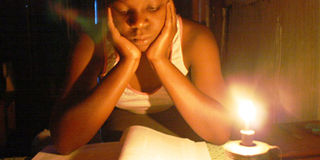Trust lighting to improve life in slums

This girl from Mukuru slum in Nairobi reads using a kerosene tin lamp for lighting. PHOTO | FILE | NATION
What you need to know:
Access to services in public facilities such as health centres, police posts and chief camps near the lit-up areas has been enhanced even at night, as has security.
More investors are now expanding housing facilities or putting up new ones on improved demand by would-be tenants calmed by the improved security.
Households have discarded harmful sources of lighting like kerosene tin lamps that contributed to respiratory diseases and other complications.
For decades, thousands of households in informal settlements have been routinely forced to be indoors by nightfall since their neighbourhood is not lit and, therefore, there is no socio-economic activity outside then. Darkness means residents have to rush home and businesses close early for security reasons.
With poor infrastructure and crowded housing, crimes such as mugging, house break-ins and rape are common. Demand for rental space suffers as tenants keep away for fear of their safety.
FRESH PRODUCE
Thanks to initiatives to provide lighting, however, the situation is gradually improving. One such initiative is by the Kenya Informal Settlement Improvement Project (Kisip), whose infrastructure upgrade programme includes installation of high mast lighting that has boosted the socio-economic status of thousands of livelihoods.
Businesses in areas like Kayole Soweto in Nairobi, Obunga (Kisumu) and Kasarani (Naivasha) operate for longer and customers shop conveniently as late as midnight. Female residents in informal settlements such as Kamukunji in Eldoret are grateful as the risk of sexual assault has reduced and, as a result, women traders can leave their houses and source for food and supplies from the fresh produce market as early as 5am.
Children in Obunga have taken advantage of the lighting to do their homework or play in fields well lit by floodlights. For Milimani High School in Kericho, the floodlights illuminate wider areas, giving the students and teachers a sense of security.
HARMFUL SOURCES
Access to services in public facilities such as health centres, police posts and chief camps near the lit-up areas has been enhanced even at night, as has security. More investors are now expanding housing facilities or putting up new ones on improved demand by would-be tenants calmed by the improved security.
Households have discarded harmful sources of lighting like kerosene tin lamps that contributed to respiratory diseases and other complications.
The benefits of the lights are overwhelming; many counties have adopted the concept to light up informal settlements and public spaces like markets. But even with the initial success, focus must remain on the long-term sustainability of the initiative that largely depends on continued financial and technical support from the counties.
POWER BILLS
The cost of running the masts is high. In Mombasa, for example, the county street lighting team estimated the average monthly electricity bill per mast at Sh13,000-15,000. This cost, when multiplied by the number of high mast lights, can be substantive. Nakuru, for example, spends some Sh18 million a month on the street lighting bill. Gladly, the counties have started undertaking these financial and technical obligations despite concerns about operation costs.
There are options that can be explored to leverage the masts. Counties could exploit the advertising opportunities provided on the lighting masts to help to offset part of the power bills.
Sadly, the masts remain bare despite a monthly revenue potential of Sh50,000 each. This is sufficient to keep the lights on throughout the month. Solar panels, despite the substantial initial installation costs, have a myriad of benefits, including reduced monthly bills and low maintenance costs and are environment-friendly.
FLUSH OUT VANDALS
The counties could partner with the national government for cheaper power supplies to run the high masts. Generation of power from cheaper sources such as wind and geothermal has increased and the benefits could be extended to the high mast lighting.
Counties should lobby utility firm Kenya Power and state agencies involved in security and trade to supply bigger-capacity transformers to informal settlements.
Besides the power bills, focus also on fighting vandalism. Components such as power meter boxes are an easy target by vandals and these could be protected by installing cages.
More importantly, sensitisation of communities on the protection of the light masts would be critical. Inculcating community ownership of the initiative is an effective way of flushing out vandals because the benefits of sufficient lighting cannot be gainsaid.
PEAK HOUSE
Lastly, sustaining the initiative requires more or bigger transformers in most informal settlements. There is obviously increased demand for power, especially during peak hours, and it is only necessary that bigger-capacity equipment is installed to prevent outages due to system overloads.
In Nyalenda, Kisumu, Kisip beneficiaries have reported of power outages that would last for more than two days. KCC in Nairobi, Mkomani (Mombasa) and Huruma (Eldoret) have also reported gradual dimming of some of the high mast lights.
Mr Mugwika, an engineer, is the head of infrastructure component at Kisip. [email protected]




